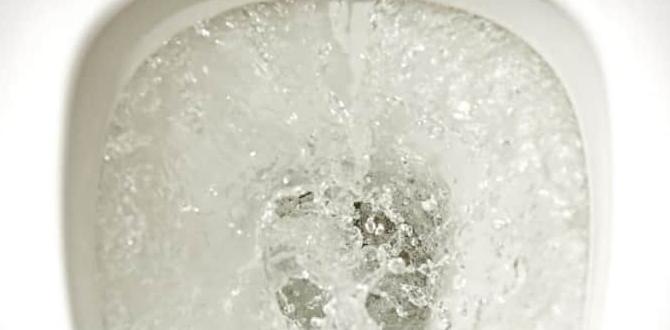Have you ever heard strange sounds coming from your toilet? It might sound like a grumbling monster! This can be pretty annoying, especially in the quiet of the night. But there’s good news! You can learn how to fix a noisy toilet easily.
Imagine trying to sleep while your toilet clanks and whistles. Isn’t that frustrating? Many people face this problem. But don’t worry! With a few simple steps, you can silence that noise.
Did you know that a noisy toilet often hints at a bigger issue? Sometimes, it’s just a small part that needs fixing. Understanding how to fix a noisy toilet can save you time and money. There’s a sense of satisfaction in solving it yourself. Ready to give it a try?
How To Fix A Noisy Toilet: Easy Solutions And Tips

How to Fix a Noisy Toilet
Nobody likes a noisy toilet. It can be annoying and distracting. First, check the fill valve. Sometimes, adjusting it solves the problem. If it’s too high, it might cause a gurgling sound. Did you know that a worn-out flapper could also create strange noises? Replacing it is a quick fix. Lastly, ensure your toilet is level. An uneven base may cause rattling. Fixing these issues can bring peace back to your bathroom!Common Causes of Noisy Toilets
Flushing mechanism issues. Water valve problems.Noisy toilets can be a real headache. Often, the culprits are easy to spot. First, look at the flushing mechanism. If it wiggles or makes strange sounds, it may need some tightening or a new part. Next, check the water valve. A faulty valve can cause water to rush like it’s running a race! Sometimes, it just needs a simple adjustment. Don’t worry, it’s easier than explaining why a toilet has a “funny” voice!
| Common Causes | Fix |
|---|---|
| Flushing Mechanism Issues | Tighten or replace parts |
| Water Valve Problems | Adjust or replace valve |
Identifying the Type of Noise
Distinguishing between gurgles, hisses, and bangs. Understanding the implications of each sound.To fix a noisy toilet, first listen closely. Different sounds help you find the problem. For example:
- Gurgles often indicate a clog in the pipes.
- Hisses can mean a leaking valve or a loose connection.
- Bangs usually signal water hammer, which needs attention.
Each noise tells a story about what might be wrong. Understanding these sounds can help you take the right steps to solve the issue.
What does gurgling mean in a toilet?
Gurgling usually hints at a blockage in the pipes, which could lead to more serious problems.Step-by-Step Guide to Troubleshooting
Visual inspection of the toilet components. Checking water supply lines.Start by looking closely at the toilet parts. Check for any visible problems. Leaks or cracks can cause noise. Next, inspect the water supply lines. Ensure all connections are tight. A loose connection can create weird sounds.
- Look for worn-out parts.
- Check the fill valve for issues.
- Make sure the water line isn’t bent or clogged.
These steps help you spot the source of the noise. Fixing these issues early can save you from bigger problems later.
What are common causes of a noisy toilet?
Common causes include a faulty flapper, a defective fill valve, or high water pressure. Taking a close look can help solve the noise problem.
Adjusting the Float and Valve Mechanism
Instructions on float height adjustment. How to replace or repair fill valves.If your toilet sounds like a drum solo, it might be time for some adjustments. First, check the float height. You want it to sit just above the water line. If the float’s too low, it keeps the valve open, creating noise. Need to fix that fill valve? Use a wrench to loosen the old one and simply twist in the new one. Make sure to tighten it well, or it might think it’s auditioning for a water park!
| Task | Steps |
|---|---|
| Adjust Float Height | Raise it above the water line. |
| Replace Fill Valve | Unbolt the old one, then tighten in the new valve. |
Resolving Water Hammer Issues
Explanation of water hammer phenomenon. Installing water hammer arrestors.Have you ever heard a loud bang when your toilet fills up? That’s water hammer! It happens because of sudden changes in water flow. This can create noise, making your home feel less peaceful. To fix it, you can install water hammer arrestors. These devices absorb the shock of water and stop the noise. Here’s how:
- Turn off your water supply.
- Find a suitable spot for the arrestor, usually near the toilet.
- Attach it to the pipe, making sure it’s secure.
- Turn the water back on and enjoy your quiet toilet!
What causes water hammer?
Water hammer occurs due to sudden stops in water flow, creating pressure waves that cause noise.
How do you prevent water hammer?
You can prevent it by properly installing a water hammer arrestor, which cushions the water flow and stops the irritating sound.
Cleaning and Maintaining the Toilet Components
Importance of regular cleaning. Recommended cleaning solutions and methods.Keeping your toilet clean is not just about making it shine; it’s also key to stopping those annoying noises! Regular cleaning helps parts stay in good shape and can even prevent tricky issues. Using simple solutions like vinegar and baking soda works wonders. Try using a toilet brush weekly to scrub away grime. Remember, a clean toilet is a happy toilet, and happy toilets don’t make noise!
| Cleaning Solution | Method |
|---|---|
| Vinegar | Add 2 cups to the bowl and let it sit for 30 minutes. |
| Baking Soda | Sprinkle in the bowl, scrub, then flush for freshness! |
Remember: A clean toilet may just keep the peace in your home. After all, nobody likes a cranky commode!
When to Call a Professional Plumber
Signs of severe plumbing issues. Cost considerations for professional help.If your toilet makes strange sounds, it might be serious. Look for these signs:
- Water pooling around the base
- Continuous running water in the tank
- Slow drains in other parts of the house
- Unusual odors
Professional plumbers can help. However, their services can cost $100 or more. Sometimes, fixing a small issue early saves more money later. Trust your instincts: if something feels off, call a pro!
When should I get a plumber for my toilet?
If your toilet keeps making noise or shows other signs, call a plumber. It’s better to be safe!
Conclusion
To fix a noisy toilet, start by checking for loose parts. Tightening components and replacing worn washers can help. If the noise continues, consider adjusting the fill valve or float. Remember, a quiet toilet improves your home’s comfort. You can explore more tips online or ask an adult for help. Let’s tackle that noise together!FAQs
What Are The Common Causes Of A Noisy Toilet, And How Can I Identify Them?Common causes of a noisy toilet include a loose fill valve, a bad flapper, or a worn-out ballcock. You can check the fill valve by listening for strange sounds when the tank fills. If the flapper doesn’t close tightly, water will keep running, causing noise. Look for water trickling into the bowl. Finally, a worn-out ballcock can make a humming sound. If you hear these noises, it might be time to fix your toilet.
How Can I Fix A Toilet That Makes A Hissing Or Running Sound?To fix a toilet that hisses or runs, first check the float. The float helps the tank fill with water. If it’s stuck, gently lift it. Next, look at the flapper, a piece at the bottom of the tank. If it’s not sealing, it might need replacing. Finally, tighten the water supply line if it’s loose.
What Steps Should I Take To Silence A Toilet That Is Constantly Filling Or Cycling?To fix a toilet that keeps filling or cycling, start by turning off the water valve behind the toilet. Next, remove the tank lid and check the float. The float should not be too high or low; adjust it so it sits neatly above the water line. You can also check for leaks around the flapper, which is a rubber part at the bottom of the tank. If it’s worn, you may need to replace it. Finally, turn the water back on and check if the problem is fixed.
Are There Specific Parts Of The Toilet That Should Be Replaced To Eliminate Noise?Yes, you can replace a few parts to help with noise. Start with the fill valve, which controls the water flow. If the toilet makes a loud noise when it fills, changing this part can help. You can also replace the flapper, which seals the water in the tank. If you fix these parts, your toilet should be quieter!
How Can I Prevent Future Noise Issues In My Toilet After Making Repairs?To stop noise in your toilet after fixing it, you can do a few things. First, check all the pipes to make sure they are tight and don’t move around. Next, replace old washers or seals that might be worn out. You can also try adjusting the float in the tank, so it works better. Lastly, listen for any sounds after you flush to catch issues early!








